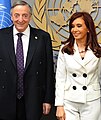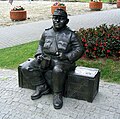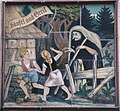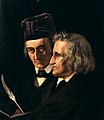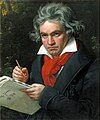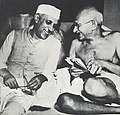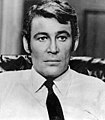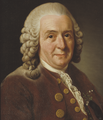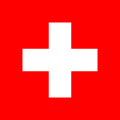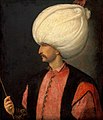Cultural icon - Simple English Wikipedia, the free encyclopedia

A cultural icon can be a symbol, logo, picture, name, face, person, building, or other image. It is easily recognized and generally represents an object or idea with great cultural significance to a wide cultural group. It has a special status as representing, or important to, or loved by, a particular group of people, a place, or a period in history.
In the media, many well-known examples of popular culture have been called "iconic". Some writers say that the word is overused.[1][2][3]
Icons and persons[change | change source]
According to Times of India:
Che Guevara, Madonna, Jim Morrison, James Dean, Marilyn Monroe, John Lennon, Michael Jackson, Frank Sinatra, Bob Marley, Elvis Presley, Kurt Cobain, the Beatles, Elizabeth Taylor, Walt Disney — these are names that refuse to fade out. No generation gap can lower their popularity. They will always remain a symbol of youth.
— Times of India, July 1, 2009, [4]
Icons and brands[change | change source]
Brands can show social values and changes, but many people have become tired of them.[5] Many brands want to be cultural icons, but fail. Cultural icons are often timeless, imprinted in our consciousness. They can go through several stages, from "rumblings, undercurrents" via "catharsis, explosion" and "mass acceptance, ripple effect" to "glorification, representative value". While brands are rational and driven by features, cultural icons are emotional, free, driven by feeling, and creating emotional bonds. An example of "branding" might include the wearing of a consistent fashion look by such music stars as Michael Jackson or Elvis Presley, making them instantly recognizable. Royal or church clothing could also be understood as a form of emotional iconography.
Examples include: Andy Warhol, Budweiser, BMW, Chanel, Coca-Cola, Guinness, Harley-Davidson, LEGO, Martha Stewart, Nike, Norman Rockwell, Vuitton, Škoda Auto...
Definition[change | change source]
Cultural icons may be national, regional or about a city. And they can be symbols for a nation, or can show the values held by that state. For example, France uses Marianne as a symbol of the French Revolution. Bruce Lee is a symbol for the martial arts and philosophical culture of insight and knowledge in the entire world.[6][7][8] Charlie Chaplin symbolises comical action while Clint Eastwood is a symbol for strength and masculinity. Jackie Chan is a global icon of comical stunts and martial arts based action.[9] Salvador Dalí is the worldwide icon for the bizarre and eccentric.
Media overuse[change | change source]
Some writers say that the terms "icon" and "iconic" have been overused. A writer in Liverpool Daily Post calls "iconic" "a word that makes my flesh creep", a word "pressed into service to describe almost anything".[1] The Christian Examiner added "iconic" and "amazing" to its list of overused words. It found over 18,000 "iconic" references in news stories alone, with another 30,000 for "icon", including use of it for SpongeBob SquarePants.[2]
Icons by selected countries[change | change source]
Argentina[change | change source]
Australia[change | change source]
Austria[change | change source]
Brazil[change | change source]
Belgium[change | change source]
Canada[change | change source]
- Lacrosse
- Canada Goose Jackets
- The northern lights
China[change | change source]
- Eight Tigers
- Bruce Lee Statue at the Avenue of Stars
Colombia[change | change source]
Cuba[change | change source]
- Cuban Sandwich
Czech Republic[change | change source]
Denmark[change | change source]
Ecuador[change | change source]
Egypt[change | change source]
- Ptolemy XIII
France[change | change source]
- French Empire & French language
- Hermes
- Balmain
- Givenchy
Germany[change | change source]
- Lederhosen: traditional Bavarian clothing
- Knights Teutonic
- Walther firearms
- Smart Automobile
- Procession of Princes mural
- Berlin's Victory Column
- Pariser Platz
- Landeck Castle
- Trabant cars: icon of former communist East Germany
Greece[change | change source]
Hungary[change | change source]
India[change | change source]
- Indian Freedom Fighters: Bhagat Singh, Shivaram Rajguru, Sukhdev Thapar
- Shaheed-e-Azam Bhagat Singh
- Chandra Shekhar Azad
- Ram Prasad Bismil
- Ashfaqullah Khan
- Durgawati Devi (Durga Bhabi)
- Shaheed-i-Azam Udham Singh
- Dr. B. R. Ambedkar
- Anti-imperialism
- Gandhi Family
- Indian Spices
- Indian Clothing
- Lion Capital of Ashoka
- Buddhism (historical Birthplace)
- Dalai Lama (refugee in India)
- Jainism (historical Birthplace)
- Field Hockey
- Indian Cricket Team & Cricket
- Yuvraj Singh
- Holi (festival)
- Royal Enfield Motorcycles
- Indian Classical Music
Ireland[change | change source]
Israel[change | change source]
Italy[change | change source]
- Leonardo da Vinci
- Beretta & Beretta 92
- Fendi
- Salvatore Ferragamo
- Max Mara
- Moschino
- Bulgari
- Diesel
- Papal Guard
Jamaica[change | change source]
Japan[change | change source]
- Infiniti
- Isuzu
- Kiyomizu Temple, Kyoto
- Todaiji Temple in Nara
- Great Buddha at the Todaiji Temple in Nara
Korea[change | change source]
- Korean peninsula
- Flag of South Korea
- Flag of North Korea
- Hanbok (female and male)
- Taekwondo, Korean martial arts
- Gyeonghoeru (Royal Banquet Hall) at Gyeongbokgung Palace, Seoul
- BTS (Kpop group) boy band
- Korean Kimchi
- Korean Metal Chopsticks
- Hyangwonjeong (Winter, 2013) - Korean snowy winters
- Chosŏn'gŭl/Hangul, Korean native alphabet
Mexico[change | change source]
Nepal[change | change source]
- Gorkha Regiment
- Khukri Knife
Netherlands[change | change source]
North Macedonia[change | change source]
Norway[change | change source]
New Zealand[change | change source]
- Lake Tekapo
- Southern Lights
Pakistan[change | change source]
Portugal[change | change source]
Russia[change | change source]
- Narodnaya Volya
- MIG
- Samovar
- Vodka
Saudi Arabia[change | change source]
- Zamzam Well
Serbia[change | change source]
South Africa[change | change source]
Spain[change | change source]
- Cervantes and Don Quijote
- Balenciaga
- Zara
Sweden[change | change source]
- Polestar
- Pewdiepie, video game commentator
Switzerland[change | change source]
- Matterhorn Mountain
- Swiss Banking System
- Moleson peak
Turkey[change | change source]
- Sultan Ahmed Mosque (Blue Mosque)
- Galata Tower
United Kingdom[change | change source]
- British East India Company & British Raj
-


 French
French Deutsch
Deutsch








